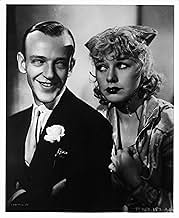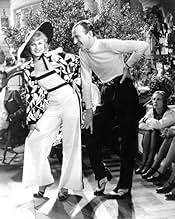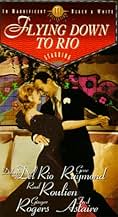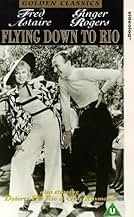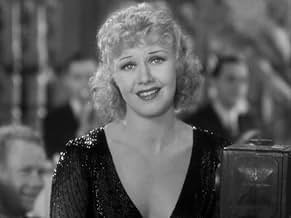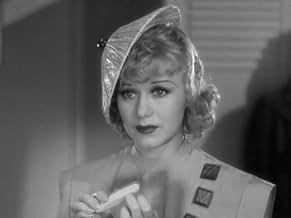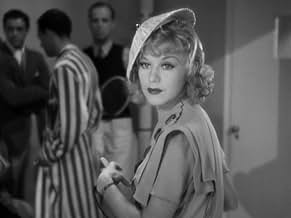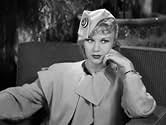Roger, un músico americano, se enamora de Belinha De Rezende, una aristócrata brasileña. Pero ella ha de regresar a Brasil a casarse para salvar a su padre. Roger, acompañado por su banda, v... Leer todoRoger, un músico americano, se enamora de Belinha De Rezende, una aristócrata brasileña. Pero ella ha de regresar a Brasil a casarse para salvar a su padre. Roger, acompañado por su banda, viajará hasta Brasil para impedir el matrimonio.Roger, un músico americano, se enamora de Belinha De Rezende, una aristócrata brasileña. Pero ella ha de regresar a Brasil a casarse para salvar a su padre. Roger, acompañado por su banda, viajará hasta Brasil para impedir el matrimonio.
- Nominado a 1 premio Óscar
- 2 nominaciones en total
- Belinha De Rezende
- (as Dolores Del Rio)
- Rio Casino Manager
- (sin créditos)
- Singer
- (sin créditos)
- Check Girl
- (sin créditos)
Argumento
¿Sabías que…?
- TriviaStanding outside a bakery shop in Rio, Ginger Rogers asks, "Oh, Freddie, how do you ask for little tarts in Portuguese?" Fred Astaire replies, "Don't heckle me, try the Culbertson System." This pre-Code, double entendre joke would have been funny to Depression-era audiences, for whom bridge was a common pastime. Ely Culbertson was a champion bridge player and worldwide celebrity, who had won several international tournaments by developing a rather aggressive bidding system. He was also notorious for his sexual exploits. His 1940 autobiography was banned in many countries. In the 1930s, the word "tart" was equivalent to "slut" or "whore". Also, in the opening inspection of hotel staff, the boss sees a maid whose shoe heels are oddly beveled and says he will not tolerate that sort of thing. A "round-heeled woman" was 1930s slang for a prostitute, a woman who could tilt easily from standing to being on her back.
- ErroresFrom the height they were flying, most of the "dance" routines of the young women on the plane wings would not be visible to people on the ground.
While true, this observation is not a Goof. The purpose of the event likely was more for advertising or Newsreel value, or even simply "bragging rights".
- Citas
Belinha's Friend: What have these South Americans got below the equator that we haven't?
- ConexionesFeatured in Hollywood and the Stars: The Fabulous Musicals (1963)
- Bandas sonorasMusic Makes Me
(1933) (uncredited)
Music by Vincent Youmans
Lyrics by Gus Kahn and Edward Eliscu
Performed by Ginger Rogers
With the music and lyrics by Gus Kahn, Edward Eliscu and Vincent Youmans, the songs include: "Music Makes Me" (sung by Ginger Rogers in the foreground with Fred Astaire, as one of the members of the band, playing the accordion in the background); "The Carioca" (performed by musicians, danced by numerous Brazilians, sung by Movita and Etta Moten, and danced briefly by Astaire and Rogers); "Orchids in the Moonlight" (sung by Raul Roulien to Dolores Del Rio/reprise, danced by Astaire and Del Rio, with one observer saying to another, "Oh, look, Belinha is dancing our tango with an Americano."); "Music Makes Me" (tap dance solo by Astaire); and "Flying Down to Rio" (sung by Fred Astaire/ danced by girls chained to the wings of the flying airplanes).
Other than some advanced camera techniques used in this production, portions of the movie play like a picture postcard advertisement, mainly during its montage sequences where the camera focuses first from an air-view of famous landmarks, then from the ground view of Rio De Janiero, and flipping over to other scenes of the city from people walking the streets to cars driving down the roads before returning to the storyline.
In the supporting cast are Blanche Frederici as Belinda's old-fashioned Aunt (Tia) Elena; Roy D'Arcy, Maurice Black and Armand Kaliz (The Greeks); Franklin Pangborn (Mr. Hammerstein); Luis Alberni (The Rio Casino Manager); and Eric Blore (Mr. Butterbass), making his first of five performances in an Astaire and Rogers musical. He is an asset to every one of them. It's also interesting to note that Raul Roulien remained somewhat obscure after appearing in this, never to become the Cesar Romero-type of Hollywood. As for the few Hollywood movies to feature him in the early 1930s, this is the only one still in circulation today and possibly his best opportunity on screen.
When Gene Raymond was interviewed about FLYING DOWN TO RIO in the documentary on RKO Radio titled "Hollywood, the Golden Years" (as narrated by Ed Asner back in the late 1980s), he mentioned that he thought that FLYING DOWN TO RIO was going to become the "Bomb of Bombs," but much to his surprise when it made its premiere during the Christmas season at Radio City Music Hall, he noticed while being in New York City that there was a long line of people going around the block waiting to go in and see this movie. One cannot be sure that history would repeat itself again in today's society, but FLYING DOWN TO RIO, in spite of whatever is right or wrong it it, is vintage entertainment at best. Only one debit: acrobats flipping and catching one other, and hanging on the swings under the wings of the flying airplane during the "Flying Down to Rio" number. Not realistic, but it got by. And on the historical side, this is where Astaire and Rogers got their start together on screen, thus, becoming the most popular song and dance team of the movies, never to be topped or equaled by anyone. Now that's something to think about!
FLYING DOWN TO RIO, which was formerly shown on American Movie Classics for many years, is currently presented on Turner Classic Movies. It is also available on video cassette and DVD. Recommended highly to fans of the team and/or musicals from this era. (***1/2)
- lugonian
- 31 ene 2002
- Enlace permanente
Selecciones populares
- How long is Flying Down to Rio?Con tecnología de Alexa
Detalles
Taquilla
- Presupuesto
- USD 462,000 (estimado)
- Tiempo de ejecución1 hora 29 minutos
- Color
- Relación de aspecto
- 1.37 : 1
Contribuir a esta página



